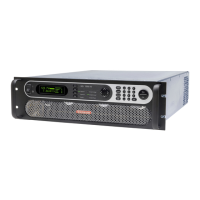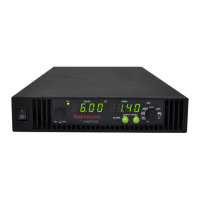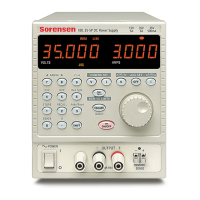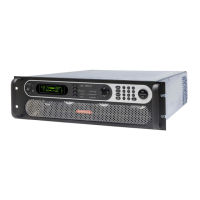
Do you have a question about the Ametek Sorensen SG Series and is the answer not in the manual?
| Output Type | DC |
|---|---|
| Control Interface | Analog |
| Programming | Voltage and Current |
| Protection | Overvoltage, overcurrent, overtemperature |
| Operating Temperature | 0°C to 50°C |
| Cooling Method | Fan |
| Dimensions | Varies by model |
| Weight | Varies by model |
Provides instructions for remote programming control and monitoring of SG series power supplies.
Guides users to relevant sections for GPIB/RS232 interface features, configuration, and SCPI commands.
Guides users to relevant sections for Ethernet interface features, configuration, and SCPI commands.
Introduces features, functions, and specifications for IEEE 488.2 GPIB and RS232 interfaces.
Lists key features of the GPIB and RS232 interfaces, including programming, protection, command sets, and interfaces.
Details functions that can be programmed via GPIB/RS232, such as voltage, current, limits, and output control.
Lists functions available for reading back status and parameters via GPIB/RS232, including measurements and error codes.
Provides technical specifications for GPIB/RS232 interfaces, including programming and readback accuracy and resolution.
Illustrates SG power supply rear panel layouts and describes components relevant to RS232 and GPIB options.
Provides reference for RS232 configuration requirements, including baud rate, data bits, parity, and cable pinout.
Outlines the setup procedure for IEEE 488.2 GPIB, including address selection and communication testing.
Explains the use of DIP switches on the rear panel for configuring the supply for GPIB or Ethernet systems.
Describes how to set the rear panel switch to select between remote and local operation modes.
Details how to configure the PON SRQ switch to generate a GPIB service request upon power-on.
Explains the connection of GPIB cable shield to chassis ground for noise reduction.
Describes how to select the GPIB address for the unit using DIP switches or front panel menus.
Explains RS232 interface operation, including baud rates, data bits, and limitations.
Covers the Ethernet Interface Option for SG series power supplies, enabling remote control via Ethernet protocols.
Lists minimum software and equipment requirements for PC connection and Internet/LAN connection.
Details Ethernet interface features, including connectivity, compliance, web server, and programmable functions.
Lists key features of the Ethernet interface, such as 10/100base-T, LXI compliance, and built-in web server.
Details functions programmable via Ethernet, including voltage, current, limits, and output control.
Lists functions available for reading back status and parameters via Ethernet, including measurements and error codes.
Provides technical specifications for the Ethernet interface, including LAN configuration and factory defaults.
Details Ethernet/LAN standards, technology, protocols, IP assignment, and security features.
Lists factory default parameters for Ethernet configuration, including hostname and IP address.
Specifies programming resolution for voltage, current, and overvoltage protection via Ethernet.
Specifies programming accuracy for voltage, current, and overvoltage protection via Ethernet.
Specifies readback resolution for voltage and current via Ethernet.
Specifies readback accuracy for voltage and current via Ethernet.
Illustrates SG power supply rear panels and describes components relevant to the Ethernet option.
Details methods for configuring the Ethernet interface, including setting IP addresses via DHCP, Auto-IP, serial port, or web page.
Provides steps for network setup using DHCP to assign an IP address to the power supply.
Explains how to set up the network using Auto-IP addressing if DHCP is unavailable.
Describes how to set up network configuration using the serial COM port.
Details network setup by accessing the power supply's web page via a browser.
Explains the use of DIP switches for configuring the Ethernet connection.
Describes how to set the rear panel switch to select remote or local operation for Ethernet.
Details the 10-pin Molex connector for external auxiliary control signals.
Outlines the four basic methods for communicating with the power supply via Ethernet.
Explains communication via a raw socket interface, including socket number, IP address, and delimiter.
Describes using the VXI-11 protocol for configuring the power supply in a test system.
Details communication via the built-in web server using a supported web browser.
Provides an overview of the power supply's web pages, including banner, tabs, and user permissions.
Describes the default information-only home page displaying current supply information.
Explains how users with FULL permissions can configure IP settings for the power supply.
Details the Settings page for viewing and changing output parameters and status.
Describes the Status page, displaying information on output, trigger, OVP, fault, and calibration dates.
Details the Power page (SGI only) displaying programmed limits and output power.
Explains the Presets page (SGI only) for editing, saving, and recalling stored values.
Describes the Security page for setting up user accounts and permission levels.
Describes the operation of the Digital Interface Adapter (DIA) using IEEE 488.2, Ethernet, and SCPI commands.
Explains SCPI status reporting data structures, including status registers and enable mask pairs.
Details the SCPI Status Byte register, its bits, and how to read and clear it.
Explains the Standard Event Status Register (ESR) and its role in SCPI status reporting.
Describes the Protection Condition and Event Status Registers for monitoring power hardware status.
Explains the Operation and Questionable Status Registers and their SCPI compatibility.
Details the SCPI Error/Event Queue, how it's queried, and defines error codes.
Explains serial poll operation and its effect on the Status Byte and Service Request.
Provides information on Ethernet DIA compliance with LXI, VXI-11, and SCPI standards.
Defines parameter types and their valid arguments used in SCPI commands.
Lists valid units accepted as suffixes for numeric values in SCPI commands.
Explains SCPI conventions for optional commands and shorthand notation.
Describes SCPI query syntax and expected response termination.
Lists common SCPI commands mandatory by IEEE 488.2, applicable to all SCPI instruments.
Details the SOURCE subsystem commands for controlling voltage, current, and power.
Presents a tree summary of SOURCE subsystem commands.
Provides a tabular reference for SOURCE commands, indicating SCPI compliance.
Explains the ramp function for transitioning voltage or current over time.
Details the MEASURE subsystem commands for reading voltage, current, and power.
Presents a tree summary of MEASURE subsystem commands.
Provides a tabular reference for MEASURE commands, indicating SCPI compliance.
Details the OUTPUT subsystem commands for controlling isolation, polarity, protection, and sense relays.
Presents a tree summary of OUTPUT subsystem commands.
Provides a tabular reference for OUTPUT commands, indicating SCPI compliance.
Details the STATUS subsystem commands for managing operational, protection, and questionable status.
Presents a tree summary of STATUS subsystem commands.
Provides a tabular reference for STATUS commands, indicating SCPI compliance.
Details the SYSTEM subsystem commands for error handling, local/remote control, and network configuration.
Presents a tree summary of SYSTEM subsystem commands.
Provides a tabular reference for SYSTEM commands, indicating SCPI compliance.
Details HTRIGGER commands for initiating sequences or ramps via external user interface signals.
Presents a tree summary of HTRIGGER subsystem commands.
Provides a tabular reference for HTRIGGER commands, indicating SCPI compliance.
Describes the programming of soft trigger functions for sequences and ramps.
Presents a tree summary of TRIGGER subsystem commands.
Provides a tabular reference for TRIGGER commands, indicating SCPI compliance.
Details SCPI commands for performing calibration procedures.
Presents a tree summary of CALIBRATE subsystem commands.
Provides a tabular reference for CALIBRATE commands, indicating SCPI compliance.
Covers SGI power supply unique commands for programming sequences and power modes.
Advises on restrictions and guidelines for sequence programming to prevent damage.
Details the SGI-specific POWER command added to the SOURCE subsystem.
Explains the PROGRAM subsystem for programming sequences and steps.
Details the SGI-specific POWER query for measuring power.
Explains the SGI-specific SEQUENCE command for HTRIGGER.
Demonstrates SCPI command usage for controlling and reading back power supply output.
Shows SCPI commands to set output to 5 VDC @ 1A and verify the output.
Demonstrates SCPI commands to set up overvoltage protection and generate a GPIB service request.
Shows SCPI commands to change output voltage and current simultaneously upon trigger.
Illustrates using SCPI commands with an external user interface for hardware triggers.
Demonstrates SCPI commands to ramp output voltage from 5 VDC to 25 VDC in 30 seconds.
Shows SCPI commands to ramp output current from 5A to 25A in 30 seconds.
Demonstrates ramping output voltage with a trigger command.
Shows SCPI commands to set power-on initialization values and verify them.
Provides examples for creating and executing sequences, including loops and subroutines.
Explains the purpose of calibrating the DIA for IEEE 488.2, RS232, or Ethernet interfaces.
Provides setup instructions for calibration procedures across GPIB, RS232, and Ethernet interfaces.
Details the steps for calibrating voltage programming using Ethernet.
Outlines calibration for voltage program gain/offset and readback, required for Constant Power Mode.
Describes the procedure for calibrating overvoltage protection programming and readback.
Details the steps for calibrating current programming using Ethernet.
Outlines calibration for current program gain/offset and readback, required for Constant Power Mode.
Explains analog program adjustments for units with the Isolated Interface Adapter (IIA) option.
Details the steps for adjusting current mode using an external voltage source.
Details the steps for adjusting voltage mode using an external voltage source.











